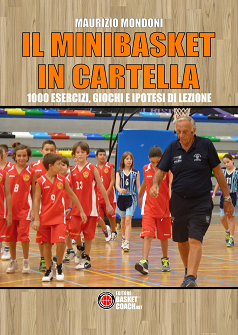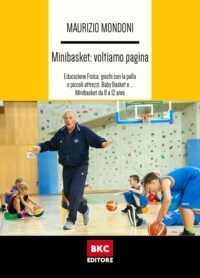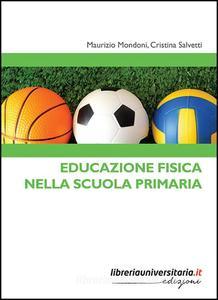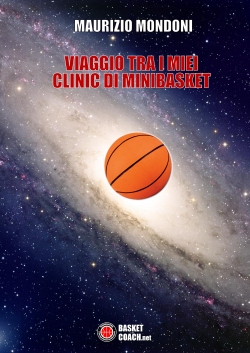2 on 2 Base Game Minibasket
2 on 2 Base Game Minibasket
In the 2 on 2 base-game we have both a 1 on 1 situation with the ball and 1 on 1 situation without the ball.
The base-game may be used with children from the age of 8 using different methods and techniques according to the age group.
In the 1 on 1 base-game seen previously, the offensive player had only one possibility, that of beating his opponent by dribbling or shooting, while the defensive player sought to become an attacker by training to regain possession.
Now in the 2 on 2 base-game the offensive player with the ball has more possibilities; in addition to dribbling and shooting he can also pass the ball to his unmarked teammate, while in defence one player still defends the ball handler while the other defends the player that is not in possession of the ball.
The player in possession of the ball must decide what to do, that is whether it is better to dribble, pass or shoot (according to the distance from the basket and from the defender).
For instance: if the ball handler has no defender in front of him, he may decide to move closer to the basket by dribbling and if the defender counters such strategy, he may attempt to beat him by changing hands, direction or speed.
If the player cannot shoot by driving in, stopping and shooting, or by taking one step and shooting, he may pass the ball to his teammate that is free.
The initial action conceived by the child (dribbling and shooting) undergoes changes (defender in front of him), meaning that the child must modify his plan of action (try to beat his opponent or pass the ball to his teammate).
To do all this he must be endowed with technical resources that he can make use of every time different situations arise during the games.
The player who has not the possession of the ball attempt to become “unmarked”, going where there is not direct opponent to receive the ball and occupy the empty spaces.
He must move quickly on court, because if he does not move it would be easier for the defender to intercept the ball in the event of a pass (he should make dummies and point out where he wants the pass). Adding together the two situations, 1 on 1 with the ball and 1 on 1 without the ball, we have a new situation of 2 on 2 in offense and defence (collaboration play).
In the 2 on 2 base-game is very important from a didactic point of view to initially limit the number of dribbles while holding the ball, obliging the player with the ball to pass the ball more often (passing is quicker than dribbling).
It is very useful to propose outnumbering situations (2 on 1) in a playful form (in a large or a small area) to make children understand that is better to pass the ball to an unmarked teammate rather than continue dribbling.
Often the player defending an attacker not handling the ball forgets about his opponent and goes towards the ball, leaving his opponent unmarked.
The leads to the following situations:
– the player handling the ball is marked by two defenders;
– the attacker that is not in possession of the ball is unmarked, but he cannot receive the ball because the ball handler is in difficulty;
– the player that is not in possession of the ball goes towards the ball handler to receive the ball;
– the ball handler finds it difficult to dribble or pass.
It would be a good idea to tell the player who is not in possession of the ball not to come too close to the ball handler, because in doing so, he could also bring his defender closer to the ball (thus impeding the movements of his teammate).
This becomes possible only when the ball handler is in difficulty and shouts “help”, in which case his teammate can move closer to receive the ball (either to receive a pass or to get the ball directly from his teammate’s hands).
The use of the “pivot foot” in these cases must be explained and the player should understand it without making the technique automated.
The 2 on 2 base-game may be used obliging children to pass the ball without dribbling, then one can introduce dribbling and finally the possibility of shooting.
The game can be points or time based. The Instructor may function as referee, running the game and stopping it in the event of rule violations, teaching the rules and being tolerant with younger children about their mistakes.
The Instructor must observe how children play and single out the problems that occur, working on them before returning to the base-game (2 on 2 free) to verify whether the corrections made have led to improvements.
The situations to be proposed are 1 on 1 with the ball, 1 on 1 without the ball, 2 on 1, 1 on 1 with the Instructor’s support, 2 on 2 full-court, 2 on 2 half-court and 2 on 2 close to the basket.
As they play, the children will undoubtedly improve, trying out real play situations (which they will later come across in games) and at the same time further developing their creativity and motor imagination.
Deep analytical work of gestures and movements should be avoided at all costs, but it is important to make children aware of “what” they must do during the game “in both offense and defence” and the Instructor must help them to solve problem-situations that arise while playing.
—————————————
ALTRI ARTICOLI GIA’ TRATTATI SUL BLOG NELLE CATEGORIE. CLICCA SULLE CATEGORIE PER LEGGERLI.
TECNICA
ESERCIZI
COMUNICAZIONE
SCUOLA E MINIBASKET
MINIBASKET NEL MONDO
PEDAGOGIA
FISIOLOGIA
VIDEO
SCARICA GRATIS LA MIA DISPENSA L’ALLEDUCATORE
Vi ricordo che potete iscrivervi alla mia newsletter gratuita, per restare sempre aggiornati sul #minibasket a misura di bambino. In regalo la dispensa l’Alleducatore.
Prof. Maurizio Mondoni
#iostoconibambini
#alleducatore
#minibasket




